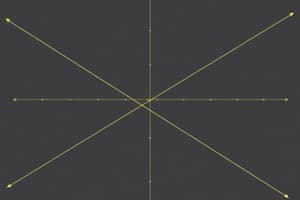Podcast
Questions and Answers
Match the vector operation property with its correct statement:
Match the vector operation property with its correct statement:
Commutativity of addition = The order in which vectors are added does not change the result. Associativity of addition = When adding three or more vectors, the grouping of the vectors does not affect the result. Identity element of addition = Adding the zero vector to any vector results in the same vector. Inverse element of addition = Adding a vector to its negative results in the zero vector.
Match each scalar multiplication property with its correct definition:
Match each scalar multiplication property with its correct definition:
Distributivity over vector addition = Scalar multiplication distributes over vector addition: $c(\mathbf{v} + \mathbf{w}) = c\mathbf{v} + c\mathbf{w}$ Distributivity over scalar addition = Scalar multiplication distributes over scalar addition: $(c + d)\mathbf{v} = c\mathbf{v} + d\mathbf{v}$ Associativity of scalar multiplication = The order of scalar multiplication can be changed: $c(d\mathbf{v}) = (cd)\mathbf{v}$ Identity element of scalar multiplication = Multiplying a vector by 1 results in the same vector: $1\mathbf{v} = \mathbf{v}$
Match the vector operation with its corresponding algebraic rule:
Match the vector operation with its corresponding algebraic rule:
Vector Addition = $\mathbf{v} + \mathbf{w} = \langle v_1 + w_1, v_2 + w_2 \rangle$ Vector Subtraction = $\mathbf{v} - \mathbf{w} = \langle v_1 - w_1, v_2 - w_2 \rangle$ Scalar Multiplication = $c\mathbf{v} = \langle cv_1, cv_2 \rangle$ Negative of a Vector = $\mathbf{-v} = \langle -v_1, -v_2 \rangle$
Match the vector operation with its geometric interpretation:
Match the vector operation with its geometric interpretation:
Match the vector operation with the property that it illustrates.
Match the vector operation with the property that it illustrates.
Match the vector operation with its corresponding effect on the vector v.
Match the vector operation with its corresponding effect on the vector v.
Match the method of vector description with its correct definition.
Match the method of vector description with its correct definition.
Match the properties of vector addition with their correct description.
Match the properties of vector addition with their correct description.
Match the vector transformation with its effect on direction.
Match the vector transformation with its effect on direction.
Relate the vector operation with its equivalent mathematical expression, given vectors v = and w = .
Relate the vector operation with its equivalent mathematical expression, given vectors v = and w = .
Match the physical quantity with its appropriate vector representation.
Match the physical quantity with its appropriate vector representation.
Match the concept with its mathematical approach.
Match the concept with its mathematical approach.
Match the vector type with its correct description.
Match the vector type with its correct description.
Flashcards
Zero Vector Addition
Zero Vector Addition
Adding the zero vector to any vector v results in the vector v itself.
Vector Subtraction
Vector Subtraction
To subtract vector w from vector v, add the negative of w to v: v - w = v + (-w).
Commutativity of Vector Addition
Commutativity of Vector Addition
Vectors can be added in any order: v + w = w + v
Associativity of Vector Addition
Associativity of Vector Addition
Signup and view all the flashcards
Distributivity of Scalar Multiplication over Vector Addition
Distributivity of Scalar Multiplication over Vector Addition
Signup and view all the flashcards
What is a vector?
What is a vector?
Signup and view all the flashcards
What are vector components?
What are vector components?
Signup and view all the flashcards
How do you find vector magnitude?
How do you find vector magnitude?
Signup and view all the flashcards
What is vector direction (θ)?
What is vector direction (θ)?
Signup and view all the flashcards
How are vectors added?
How are vectors added?
Signup and view all the flashcards
What is scalar multiplication?
What is scalar multiplication?
Signup and view all the flashcards
What is a unit vector?
What is a unit vector?
Signup and view all the flashcards
What is the zero vector?
What is the zero vector?
Signup and view all the flashcards
Study Notes
- A vector in two dimensions has magnitude (length) and direction.
- Vectors are graphically represented as directed line segments.
- The length of the segment indicates magnitude, the arrow indicates direction.
- Vectors can represent physical quantities, for example displacement, velocity, acceleration, and force.
Vector Components
- A vector in 2D can be described by its components along the x and y axes.
- For a vector v from the origin to (x, y), the x-component of v is x, and the y-component is y.
- The component form of v is <x, y>.
- Components can be found using trigonometry with magnitude (||v||) and direction (angle θ).
- x = ||v|| cos(θ)
- y = ||v|| sin(θ)
Magnitude of a Vector
- The magnitude (or length) of a vector v = <x, y> is found using the Pythagorean theorem.
- ||v|| = √(x² + y²)
- The magnitude is a non-negative real number.
Direction of a Vector
- The direction of a vector is the angle θ relative to the positive x-axis, measured counterclockwise.
- The angle θ is found using the arctangent function: θ = arctan(y/x).
- Adjustments to θ are needed based on the quadrant in which the vector lies.
Vector Addition
- Vectors can be added.
- If v = <x₁, y₁> and w = <x₂, y₂>, then v + w = <x₁ + x₂, y₁ + y₂>.
- Graphically, vector addition uses the "tip-to-tail" method. Place the tail of w at the tip of v, the resultant vector goes from the tail of v to the tip of w.
- Vector addition is commutative (v + w = w + v) and associative ((u + v) + w = u + (v + w)).
Scalar Multiplication
- A vector can be multiplied by a scalar (a real number).
- If v = <x, y> and c is a scalar, then cv = <cx, cy>.
- Scalar multiplication scales the magnitude of the vector by |c|.
- If c > 0, the direction is unchanged.
- If c < 0, the direction is reversed.
Unit Vectors
- A unit vector has a magnitude of 1.
- To find a unit vector in the same direction as a given vector v, divide v by its magnitude: u = v / ||v||.
- The standard unit vectors are i = <1, 0> (along the x-axis) and j = <0, 1> (along the y-axis).
- Any vector v = <x, y> can be written as a linear combination of the standard unit vectors: v = xi + yj.
Zero Vector
- The zero vector has a magnitude of 0.
- In component form, the zero vector is <0, 0>.
- The zero vector does not have a specific direction.
- Adding the zero vector to any vector v gives v.
Vector Subtraction
- Vector subtraction is similar to vector addition.
- To subtract vector w from vector v, add the negative of w to v: v - w = v + (-w).
- If v = <x₁, y₁> and w = <x₂, y₂>, then v - w = <x₁ - x₂, y₁ - y₂>.
Properties of Vector Operations
- Commutativity of addition: v + w = w + v
- Associativity of addition: (u + v) + w = u + (v + w)
- Identity element of addition: v + 0 = v
- Inverse element of addition: v + (-v) = 0
- Distributivity of scalar multiplication over vector addition: c(v + w) = cv + cw
- Distributivity of scalar multiplication over scalar addition: (c + d)v = cv + dv
- Associativity of scalar multiplication: c(dv) = (cd)v
- Identity element of scalar multiplication: 1v = v
Studying That Suits You
Use AI to generate personalized quizzes and flashcards to suit your learning preferences.




